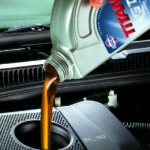Manufacturer approvals are the key to overcoming some of the increasingly complex issues surrounding engine oils. FUCHS Lubricants explains why.
With the number of lubricant products available to aftermarket specialists regularly increasing, the challenge of selecting the right product for a specific vehicle has also become more difficult.
Bespoke products
As greater emphasis has been placed on fuel economy in engines and stringent emission regulations have been introduced, OEMs have demanded bespoke products, dramatically increasing the number of OEM-approved products available on the market.
While this is undoubtedly a welcome development in the manufacturing of lubricants, it has also served to muddy the waters somewhat when it comes to selecting the correct product.
“The idea that one oil can suit everything is at least 20 years out-of-date and is a fallacy now,” says Andy Brown, UK Automotive Technical Manager for FUCHS Lubricants.
“Everyone must be aware that using the wrong product on a specific vehicle can be a very expensive mistake. For instance, if you buy a Euro 6 vehicle, it has to stay within its emission spec for five years or 100,000 km. If you use the wrong oil and it impacts and causes problems ‘downstream’, whose fault is it if it goes wrong?”
He continues: “One of the first things the manufacturer will ask is: “What oil did you use?” If it isn’t the correct OEM approved product, it leaves whoever is responsible totally exposed. That’s why we go down the approvals route so thoroughly. If you use an approved product, you know the manufacturer has seen the oil, knows the formulation and has usually tested it.
“Some oils may have six to eight OEM approvals but others may just have one. It can be that specific. The oils can be very similar, but there is enough difference now to require a new approval.”
Damage dangers
What makes selecting the right oil even more daunting is that the implications of using the wrong one can be both damaging and varied.
“If you use an oil with incorrect additive or chemical limits there is the potential to create higher levels of sulphated ash which will block the DPF,” adds Andy.
“When it regenerates, you can’t burn ash – it is already as burnt as it can be. The pressure difference across the DPF will still measure the same pressure drop so it will try to regenerate again – but it still won’t work.
“In this case the DPF will either need replacing or cleaning. Either way, you have a vehicle limping away at 30mph. The driver then has a problem with the vehicle which is costing money and causing aggravation.”
He continues: “Another potential issue could come in the catalyst in the exhaust. If you don’t use the right oil, you can poison the catalyst.
“You have metals in the catalyst which speed up the reaction, but these metals shouldn’t feature in the reaction so there should be as much left after the reaction as there was before it.
“If you put the wrong additives in, they react with that metal and, over time, it becomes less efficient. The result will be that the sensor on the vehicle will detect the catalyst isn’t working properly and you have to replace it.”










